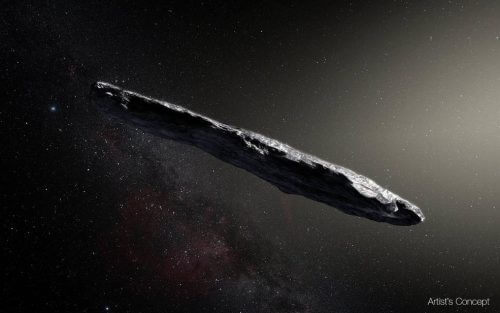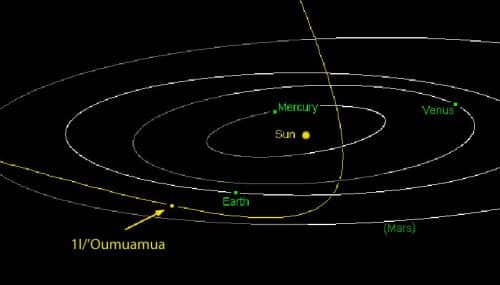Observations have shown that it is one of the most elongated cosmic objects known to science. Calculation of its orbit showed that it originated in a system of planets orbiting another star and not from our solar system. In fact, its length is 10 times greater than its width. This ratio is more extreme than that of any asteroid or comet observed in our solar system.

A large asteroid visited relatively close to Earth and was discovered on October 19. Its uniqueness - it originates in outer space and this is its only passage through the solar system. Besides the official name given to it by the World Astronomical Union interstellar asteroid 1I/2017 U1, the asteroid was nicknamed Oumuamua which means "messenger from afar who arrives first" in the native Hawaiian language. Pronounce it oh MOO-uh MOO-uh.
Observations have shown that it is one of the most elongated cosmic objects known to science. Calculation of its orbit showed that it originated in a system of planets orbiting another star and not from our solar system. In fact, its length is 10 times greater than its width. This ratio is more extreme than that of any asteroid or comet observed in our solar system. A preliminary analysis of its trajectory led the researchers to hypothesize that it is coming roughly from the direction of the bright star Vega in the northern constellation Nebula. However, it took him so long to cruise through space at a speed of 87 kilometers per second, the planet Vega was not at all in this position when the asteroid passed through the area about 300 thousand years ago.
Karen Mitch from the Institute of Astronomy at the University of Hawaii and her colleagues who observed it from a telescope belonging to the Pan-STARRS system for locating near-Earth objects, funded by NASA and determined that the length of the object is about 400 meters, and its brightness changes dramatically. The brightness changes were the first clue that Oumuamua was oddly shaped. Immediately after the discovery, many telescopes turned their gaze to the asteroid and the largest of them - the very large telescope of the Southern European Observatory in Chile.
"When we looked at the light curve data for the asteroid Asteroid, there are five objects (out of 20,000) that have light curves that suggest a mass ratio of one to 7-8. Mitch said. "Our mistakes are very small, so we are sure that he is really extended. We do not know where the axis of rotation is pointing, we assumed that it is perpendicular to the asteroid, therefore there is a projection phenomenon. The ratio of 1:10 is the minimum, it can be even longer."
But in other ways, Oumuamua resembles more familiar objects. "We also found that it is reddish in color, similar to objects in the outer solar system. This means the asteroid is completely inert, without the faintest hint of dust around it,” Mitch said.

These features show that Oumuamua is dense, composed of rock and possibly metals. It has no water or ice and its surface has been reddened by the effect of cosmic radiation over long periods of time.
It is believed to have been in interstellar space for hundreds of millions of years before it randomly encountered our solar system. "For decades there has been a theory according to which there are interstellar objects transiting in the solar system, and now for the first time - We have direct evidence of their existence." said Thomas Zorbuchen of NASA's Science Division in Washington. "This is a history discovery that opens a new window for us to study the formation of solar systems beyond our own."
If indeed it formed under conditions similar to the formation of our solar system, this indicates that many objects of the type of Oumuamua may be found in space. The interstellar visitor may provide the first evidence of this process.
As for the mystery of Oumuamua's elongated shape, Mitch explains that you have many hypotheses. One of them is that during the formation of a planetary system, a collision occurred between bodies that had molten cores. In such a situation, material was ejected and then froze in an elongated shape. Another team member estimated that a supernova explosion near the solar system from which the asteroid came caused its strange shape."

11 תגובות
Yaakov Selimi. The asteroid passed at a distance of tens of millions of km from the Earth and not 10 km or even less - at the height of the clouds. Even its special shape was not observed directly by the telescopes. In short - you did not see the asteroid.
Omuomuoa. now I know. I calmed down
On Wednesday two weeks ago I flew with my wife to Kiev and while we were at an altitude of 11 km about halfway to Kiev I saw this asteroid through the window when it was flying above the clouds but close to the clouds and in a direction opposite to the plane's flight direction
What I saw is exactly what is shown in the NASA photos. I saw that the front end of it was reddish. I managed to see it for maybe 2 or 3 seconds until it disappeared.
I told my wife that I saw something strange, not a spaceship because it didn't have a perfect round shape but narrow and long really similar to what you see in the picture
Omuomuoa
There is a way to get a ride on it. I know that 87 km per second (313,200 km/h) is ten times the speed of a rocket into space today, but
Can't give up the idea
Reminds me of the monolith from the movie 2000. Every time it appeared... something changed in evolution....
I will park with my father
What is more likely in your eyes - the asteroid is a fragment of a rock due to a collision, or a spaceship of a distant culture?
There is no reason to think that this object is an artificial object.
And even an assessment that maybe this is an object made by intelligent beings, i.e. aliens?
Why doesn't it make sense? Why does it make sense that robots made by intelligent beings from Earth would roam the planet Mars or fly to the limits of the solar system? Isn't it logical that this object is made by an intelligent culture?
Write it once in the score and I'll replace
What's the problem with writing Omuamoa (first V in Holm, second V in Shoruk, third V in Shoruk)?
What's the problem with writing Omuamoa (first Friday in the dream, second Friday in the whistle, third Friday in the whistle)?